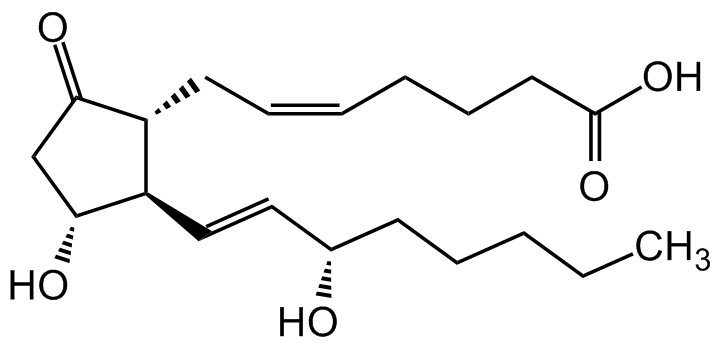
Chemical Structure
Prostaglandin E2
AG-CL1-0001
CAS Number363-24-6
Product group Chemicals
Estimated Purity>98%
Molecular Weight352.5
Overview
- SupplierAdipoGen Life Sciences
- Product NameProstaglandin E2
- Delivery Days Customer10
- CAS Number363-24-6
- CertificationResearch Use Only
- Estimated Purity>98%
- Hazard InformationDanger,Excepted quantity
- Molecular FormulaC20H32O5
- Molecular Weight352.5
- Scientific DescriptionChemical. CAS: 363-24-6. Formula: C20H32O5. MW: 352.5. Synthetic (originally isolated from sheep prostate). One of the most typical lipid mediators produced from arachidonic acid (AA) by cyclooxygenase (COX) as the rate-limiting enzyme and acts on four kinds of receptor subtypes (EP1, EP2, EP3 and EP4) with high binding affinity (Kd values range between ~1-10nM). Regulator of numerous physiological functions ranging from reproduction to neuronal, metabolic and immune functions. Implied in the regulation of body temperature and sleep-wake activity. Regulating factor for bone formation and bone healing. Potent vasodilator. Influences smooth muscle relaxation, fertility and gastric mucosal integrity (first line of defense of the intestinal immune system). Acts as a pro-inflammatory mediator, but also exerts anti-inflammatory responses. As pro-inflammatory mediator, PGE2 contributes to the regulation of the cytokine expression profile of DCs and has been reported to bias T cell differentiation towards a T helper (Th) 1 or Th2 response. Exerts anti-inflammatory actions on innate immune cells like neutrophils, monocytes and NK cells. Implicated in various tumorigenic processes. Facilitates tumor progression through stimulation of angiogenesis via EP2, mediates cell invasion and metastasis formation via EP4 and promotes cell survival by inhibiting apoptosis via numerous signaling pathways. Tumor cell-produced PGE2 has been implicated in strategies of tumors for evasion of immune surveillance. Furthermore, it can enhance the inhibitory function of human regulatory T cells. Regulates vertebrate hematopoietic stem cell (HSC) homeostasis. Inhibits NLRP3 by acting through receptor EP4 activation that increases cAMP. cAMP activates PKA that phosphorylates NLRP3 at serine 295. PKA phosphorylation of NLRP3 inhibits the NLRP3 ATPase activity, which is required for assembly of NLRP3-ASC complexes. - One of the most typical lipid mediators produced from arachidonic acid (AA) by cyclooxygenase (COX) as the rate-limiting enzyme and acts on four kinds of receptor subtypes (EP1, EP2, EP3 and EP4) with high binding affinity (Kd values range between ~1-10nM). Regulator of numerous physiological functions ranging from reproduction to neuronal, metabolic and immune functions. Implied in the regulation of body temperature and sleep-wake activity. Regulating factor for bone formation and bone healing. Potent vasodilator. Influences smooth muscle relaxation, fertility and gastric mucosal integrity (first line of defense of the intestinal immune system). Acts as a pro-inflammatory mediator, but also exerts anti-inflammatory responses. As pro-inflammatory mediator, PGE2 contributes to the regulation of the cytokine expression profile of DCs and has been reported to bias T cell differentiation towards a T helper (Th) 1 or Th2 response. Exerts anti-inflammatory actions on innate immune cells like neutrophils, monocytes and NK cells. Implicated in various tumorigenic processes. Facilitates tumor progression through stimulation of angiogenesis via EP2, mediates cell invasion and metastasis formation via EP4 and promotes cell survival by inhibiting apoptosis via numerous signaling pathways. Tumor cell-produced PGE2 has been implicated in strategies of tumors for evasion of immune surveillance. Furthermore, it can enhance the inhibitory function of human regulatory T cells. Regulates vertebrate hematopoietic stem cell (HSC) homeostasis. Inhibits NLRP3 by acting through receptor EP4 activation that increases cAMP. cAMP activates PKA that phosphorylates NLRP3 at serine 295. PKA phosphorylation of NLRP3 inhibits the NLRP3 ATPase activity, which is required for assembly of NLRP3-ASC complexes.
- SMILESO=C1[C@H](C/C=C\CCCC(O)=O)[C@@H](/C=C/[C@@H](O)CCCCC)[C@H](O)C1
- Storage Instruction-20°C
- UNSPSC12352200


![Prostaglandin E2 [363-24-6]](https://www.targetmol.com/group3/M00/37/BF/CgoaEWayUWeETcHxAAAAAHxNTmw685.png)
